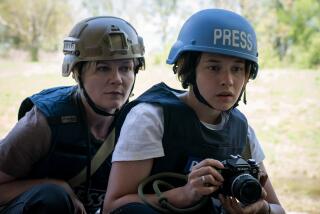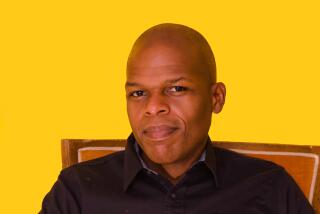It changed their lives forever
Elizabeth and Hazel
Two Women of Little Rock
David Margolick
Yale University Press: 310 pp., $26
--
For a “still” photograph, it is anything but. The image is loud, vivid and in motion: A lone black girl in an astonishingly white dress -- notebook pressed against her chest, eyes obscured by sunglasses -- navigates a gantlet of white faces. Among them, however, is one visage that distinguishes itself from the rest -- a girl, directly behind the lone one, whose expression is one of contorted, open-mouthed rage and hate.
This was the scene set in motion at Little Rock Central High on Sept. 4, 1957, when Will Counts, a photographer for the local Arkansas Democrat newspaper, aimed his camera. This, consequently, is how Elizabeth Eckford and Hazel Bryan would first “meet.” It is how they would remain linked -- for worse and then for better and then for worse again -- for more than 50 years.
“Elizabeth and Hazel: Two Women of Little Rock,” journalist David Margolick’s intricately woven and deeply affecting new book, follows not just Eckford’s and Bryan’s subsequent life paths but also sets off into the still tricky (and often treacherous) territory of race relations in this country, and how the press -- explicating, evading or exacerbating -- swirled around it.
Elizabeth’s nightmare walk didn’t end that morning after the National Guardsmen blocked the student’s entrance at Central High, nor after that day’s deluge of taunts and racial epithets, and after the news cameras followed the 15-year-old to a bus stop where she sat waiting -- for what, at first, it wasn’t clear.
There would be more: weeks and months of torment in the classroom, the halls and the locker room -- flaming spitballs, glass shards strewn on the shower floor. Not long after that momentous morning, Elizabeth was shoved, face first, down a staircase; she took to brandishing that now-iconic notebook like a shield, this time augmented with stickpins to defend herself.
“Elizabeth continued to suffer disproportionately. Apart from being the most vulnerable, she was also the most symbolically potent,” writes Margolick.
These would be the chapters that unfolded outside the media’s gaze. The most famous of the Little Rock Nine who attempted to integrate Central High that September morning carried that burden, long after she’d moved away, joined the Army, been diagnosed with post-traumatic stress disorder, had children and survived several suicide attempts. Unfinished business pulled her back to Little Rock: Because she felt “chased away,” she wanted to prove “that I could live in this situation.” Once home, she hovered dangerously close to the poverty line and was viewed by townsfolk as a ghost of Little Rock’s violent past, her life permanently scarred by her fragile emotional state, depression and, eventually, the tragic death of her son.
Although Elizabeth faded from view for a time and her rare interviews became “a barometer of her emotional state,” writes Margolick, her image served as a catalyst. Her lone walk was a metaphor and an inspiration -- for a generation of athletes, lawyers, schoolteachers. Even President Bill Clinton famously related, decades later, that when it came to matters of race, that image helped him set his moral compass.
Hazel Bryan (later, Massery), meanwhile, became a powerful symbol of a different sort -- a cautionary one. As years passed and the photo orbited the globe, “[w]ith each iteration,” writes Margolick, “her image increasingly became the official face of intolerance.” In the “universe” that photographer Counts created, Margolick suggests, “if nowhere else, Hazel was every bit as alone as Elizabeth.”
Hazel maintains that in the immediate aftermath, she didn’t give a second thought about what transpired that morning. She couldn’t have known what it would eventually say to the world not just about her or the South but also about America’s legacy of bigotry and hate. “Not for an instant did she think she’d done anything wrong. Or momentous. Or that would mark her for life.”
Hazel would go on to drop out of school, marry young, live in a trailer, have children. But that cursory sketch does not fill in her dramatic interior transformation. She began to take stock of her inadvertent role in history; she blossomed and turned introspection outward, embarking on social work and peace activism.
What many didn’t know for some time was that Hazel had apologized to Elizabeth in the early 1960s via telephone, after a white pages search (a gesture that went undocumented in the press, Margolick notes, for decades). The two didn’t meet face to face until 1987, united again within the frame of a Counts photograph -- this one on the occasion of the 30th anniversary of the Nine’s fateful walk. This time, outside the frame, the women would attempt to embark on a tentative friendship.
The contours of their individual stories baldly illustrate the workings of race and its role as a caste system in this country. The late-in-life speaking engagements and interviews bring up raw emotions for both women: resentments, frustration (Hazel is tired of apologizing; Elizabeth doesn’t think Hazel, at the very crux of it, understands what she’s apologizing about). The women become ensnared by the missed connections, the misinterpreted gestures. In 50 years, writes Margolick, “new barriers replaced the old. Black suspicions remain, now whites feel in addition to their residual prejudices, maligned, belittled, aggrieved.”
The consequence of that long-ago moment weighed heavily -- both women forever symbols of “Black” and “White,” when the subject of race is full of many shades of gray.
Margolick does much more than simply track down two aging women and have them turn the pages of their increasingly fragile memories. His choice to broaden and complicate the narrative -- to include the larger minefield of race matters and honest discourse -- is what makes this book salient, not sentimental.
Elizabeth and Hazel’s winding, rocky relationship, then, is a much more fitting and accurate metaphor for the country; this book, an attempt at a different, lasting after-image -- this time in words.
More to Read
Sign up for our Book Club newsletter
Get the latest news, events and more from the Los Angeles Times Book Club, and help us get L.A. reading and talking.
You may occasionally receive promotional content from the Los Angeles Times.









